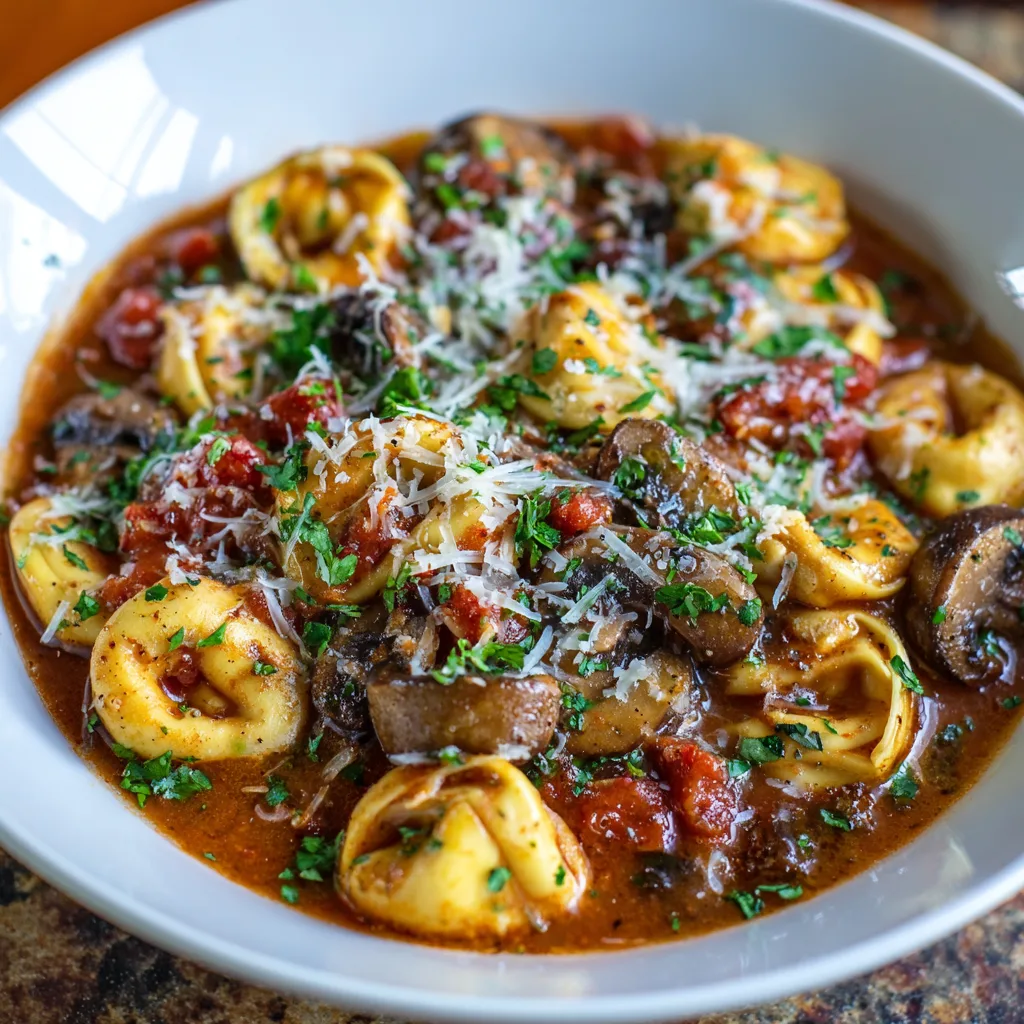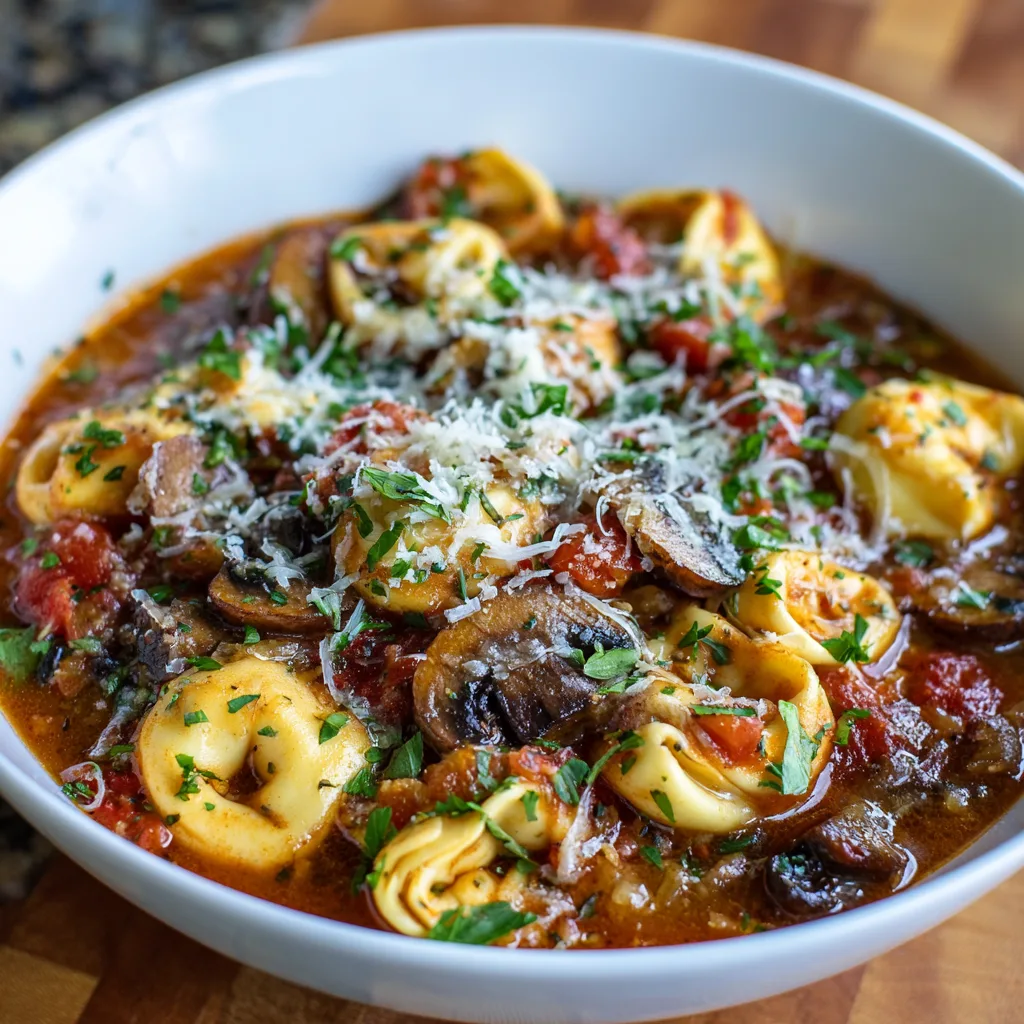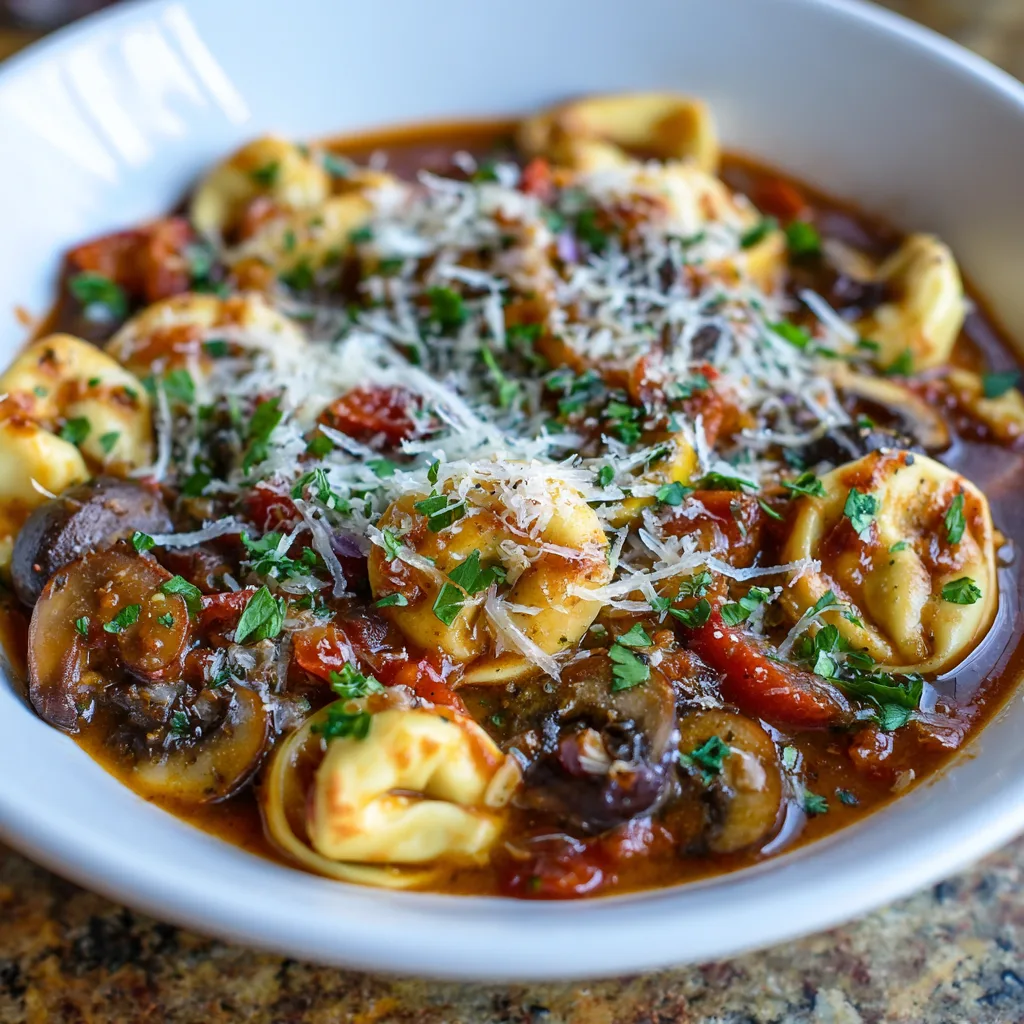Introduction to Healthy Tortellini Stew
What Is Healthy Tortellini Stew?
Healthy tortellini stew is a nourishing dish that blends tender tortellini with fresh vegetables, savory broth, and optional lean proteins. Unlike a traditional soup, this stew offers a thicker, heartier consistency that makes it a satisfying one-pot meal. Its richness comes from combining carbohydrates from tortellini, protein from cheese or meat fillings, and a variety of nutrient-packed vegetables. Each spoonful delivers a balanced mix of flavors and nutrients, making it both comforting and wholesome. By emphasizing whole ingredients and minimizing heavy creams or excessive oils, this stew provides a healthy twist on classic Italian flavors. Whether served for lunch or dinner, it stands out as a versatile, flavorful, and complete meal.
Why Choose a Healthy Tortellini Stew?
Choosing a healthy tortellini stew brings numerous benefits to the table. It is naturally high in protein, which supports muscle health and keeps you feeling full longer. The combination of fresh vegetables adds fiber, antioxidants, and essential vitamins, supporting digestion and overall wellness. This dish adapts easily to various dietary preferences, including vegetarian, gluten-free, or dairy-free versions, without compromising flavor. It also works perfectly for meal prep, storing well in the fridge, and reheating quickly on busy days. For families, it offers a crowd-pleasing, nutrient-dense option that satisfies both kids and adults. With its hearty, flavorful ingredients, this stew proves that healthy eating can be delicious and effortless.
Overview of the Article Structure
This article guides you through every aspect of healthy tortellini stew. You will explore key ingredients and their health benefits, discover dietary variations, and learn tips for preparing a wholesome meal. Additionally, frequently asked questions and a detailed recipe card template ensure you can recreate this comforting dish with confidence. By the end, you will have all the tools needed to enjoy a nutritious, flavorful, and easy-to-make tortellini stew.
Core Ingredients and Their Health Benefits
Tortellini: The Heart of the Dish
Tortellini forms the foundation of this wholesome stew, offering a tender, flavorful bite in every spoonful. Traditional tortellini comes stuffed with cheese or meat, but gluten-free and whole wheat options are increasingly popular for added health benefits. Cheese tortellini provides protein and calcium, while meat-filled versions add iron and essential amino acids. Choosing whole wheat or gluten-free tortellini increases fiber intake, aiding digestion and promoting a feeling of fullness. Each type of tortellini brings unique textures and flavors, allowing you to customize the stew to your preference. By selecting high-quality pasta, you ensure that every serving delivers both taste and nutrition, keeping the meal balanced and satisfying.
Vegetables: Adding Flavor and Nutrients
Vegetables elevate tortellini stew with color, flavor, and a powerful nutrient boost. Common choices include spinach, carrots, celery, onions, and tomatoes, each contributing vital vitamins and minerals. Spinach supplies vitamin K and iron, carrots provide beta-carotene for eye health, and tomatoes add vitamin C and antioxidants. Fiber-rich vegetables support digestion and prolong satiety, making the stew even more filling. Seasonal vegetables can be swapped in for variety, such as zucchini, bell peppers, or kale, allowing you to enjoy fresh, local produce year-round. These vibrant additions enhance both flavor and nutrition, transforming a simple stew into a wholesome, nutrient-dense meal.
Broth: The Flavor Base
The broth is the essential liquid backbone of tortellini stew, infusing every bite with savory depth. You can use chicken, vegetable, or low-sodium options depending on dietary needs. Low-sodium broths help control salt intake while still delivering rich flavors. Homemade broths provide a cleaner, more natural taste and allow control over ingredients, whereas store-bought broths offer convenience without sacrificing flavor. Beyond taste, broth contributes hydration and adds essential minerals. Using a flavorful, nutritious broth ensures your stew remains hearty and satisfying while keeping it light and healthy.
Protein Add-ins: Enhancing Satiety
Adding protein to tortellini stew makes it a complete and filling meal. Popular options include lean chicken, turkey sausage, beans, and lentils, each bringing unique nutrients and textures. Chicken and turkey provide high-quality protein and essential amino acids, while beans and lentils supply plant-based protein, fiber, and micronutrients. Protein helps stabilize blood sugar levels and prolongs satiety, keeping you energized throughout the day. Balancing protein sources allows you to tailor the stew for omnivores, vegetarians, or those seeking plant-based options. By thoughtfully incorporating proteins, your tortellini stew becomes both hearty and nourishing.
Health Benefits of Healthy Tortellini Stew
High Protein Content
Protein plays a crucial role in maintaining muscle strength, supporting immune function, and promoting overall wellness. Healthy tortellini stew provides a balanced protein source from its fillings, such as cheese, chicken, or legumes. Meat-filled or chicken-enhanced versions offer complete proteins, delivering essential amino acids for muscle repair and recovery. Cheese tortellini provides a moderate protein boost alongside calcium. For plant-based diets, beans and lentils add significant protein while keeping fat content low. Comparing different versions of the stew highlights how protein can be tailored to your needs, whether for building strength, staying full longer, or maintaining balanced nutrition. Each serving ensures a nutrient-rich meal that fuels your body efficiently.
Rich in Fiber
Fiber supports digestive health by promoting regular bowel movements and feeding beneficial gut bacteria. In tortellini stew, vegetables like spinach, carrots, and celery contribute a substantial amount of fiber, while whole-grain or gluten-free tortellini enhances daily intake. This combination improves satiety, helping control appetite and supporting healthy weight management. The blend of soluble and insoluble fiber from both vegetables and pasta stabilizes blood sugar levels and supports heart health. By incorporating fiber-rich ingredients, this stew not only satisfies taste buds but also promotes long-term digestive wellness.
Low in Unhealthy Fats
Maintaining low levels of saturated and trans fats is essential for heart health. Healthy tortellini stew achieves this by using lean proteins, such as chicken or turkey sausage, and low-fat dairy alternatives in cheese-filled tortellini. Reducing heavy cream or butter while keeping herbs and spices enhances flavor without adding unhealthy fats. Even rich, creamy versions can be adapted with plant-based or low-fat substitutes, ensuring the stew remains indulgent yet health-conscious. This careful balance allows you to enjoy a hearty, satisfying meal while supporting cardiovascular wellness.
Antioxidant-Rich Ingredients
Antioxidants protect cells from damage caused by free radicals, reducing inflammation and oxidative stress. Tortellini stew naturally incorporates antioxidants through vibrant vegetables such as tomatoes, spinach, and carrots. Tomatoes supply lycopene, a powerful antioxidant linked to heart and skin health. Spinach provides vitamin C and beta-carotene, while carrots offer additional beta-carotene for eye health and immunity. By including a variety of colorful vegetables, each bowl delivers a potent mix of antioxidants, enhancing both flavor and health benefits. This makes tortellini stew not only comforting but also a nourishing choice for long-term wellness.
Recipe Variations to Suit Dietary Preferences
Vegetarian and Vegan Options
For those following vegetarian or vegan diets, tortellini stew can be easily adapted without losing flavor. Replace meat with plant-based proteins such as tofu, tempeh, or a mix of beans and lentils. These alternatives provide essential amino acids, fiber, and added texture, keeping the stew hearty and satisfying. Use vegetable broth instead of chicken or meat-based options to maintain a vegan-friendly base. Nutritional balance is key—ensure the stew includes a variety of vegetables for vitamins and minerals while keeping protein levels adequate. Seasoning with herbs and spices enhances flavor, ensuring the plant-based version is as rich and comforting as the traditional stew. This makes the dish suitable for vegans, vegetarians, and anyone seeking a lighter, plant-forward meal.
Gluten-Free Adaptations
Gluten-free versions of tortellini stew are both simple and delicious. Start by choosing gluten-free tortellini, made from rice, corn, or chickpea flour, which preserves texture and taste. Ensure that any broth used is also gluten-free to prevent contamination. When preparing the stew, avoid using seasonings or sauces that may contain hidden gluten. Cross-contamination can be minimized by using separate utensils and cooking surfaces. Gluten-free adaptations retain all the flavor and nutrient benefits of the original recipe while supporting those with celiac disease or gluten sensitivity. This ensures the dish remains wholesome, hearty, and safe for anyone avoiding gluten.
Dairy-Free Versions
Dairy-free adaptations allow for a creamy, comforting stew without traditional cheese or cream. Replace dairy with plant-based alternatives such as almond milk, coconut cream, or cashew-based creamers. These options maintain a rich, velvety texture while reducing saturated fat and accommodating lactose intolerance. Nutritional yeast can add a cheesy flavor, complementing the tortellini and vegetables. By carefully balancing flavors and textures, the stew retains its indulgent mouthfeel while staying dairy-free. This version is perfect for those avoiding dairy or following plant-based diets, proving that a creamy, satisfying tortellini stew can be healthy, inclusive, and delicious.
Frequently Asked Questions About Healthy Tortellini Stew
Can I use frozen tortellini in the stew?
Yes, frozen tortellini works perfectly in this stew. Simply add it directly to the simmering broth, but reduce or adjust the cooking time according to the package instructions. This ensures the pasta cooks evenly without becoming mushy. Frozen tortellini adds convenience and allows you to prepare the stew quickly, maintaining both texture and flavor.
How can I make the stew spicier?
To add heat, incorporate red pepper flakes, diced jalapeños, or a few drops of hot sauce while the stew simmers. Start with small amounts and taste as you go to reach the desired spice level. This method enhances flavor without overpowering the natural taste of vegetables and tortellini.
Can I prepare the stew in advance?
Absolutely. This tortellini stew can be made ahead and stored in the refrigerator for up to three days. Keep the stew covered and airtight to preserve freshness. When ready to serve, gently reheat on the stove and stir occasionally for even warming.
How do I reheat the stew without overcooking the tortellini?
Reheat the stew on low to medium heat, stirring occasionally. If the broth has thickened or the stew feels dry, add a splash of vegetable or chicken broth. This prevents tortellini from overcooking while keeping the texture tender and flavorful.
Can I freeze the stew?
Yes, you can freeze this stew in airtight containers for up to three months. To maintain tortellini texture, consider freezing the stew without the pasta and adding fresh tortellini when reheating. This keeps the dish tasting fresh and preserves the integrity of the pasta.




